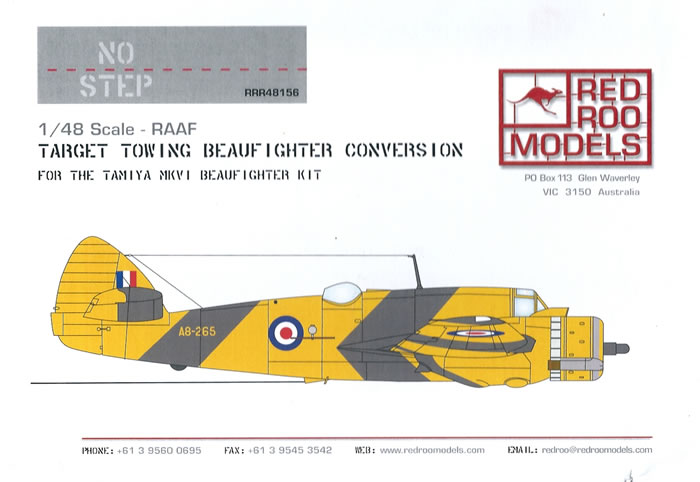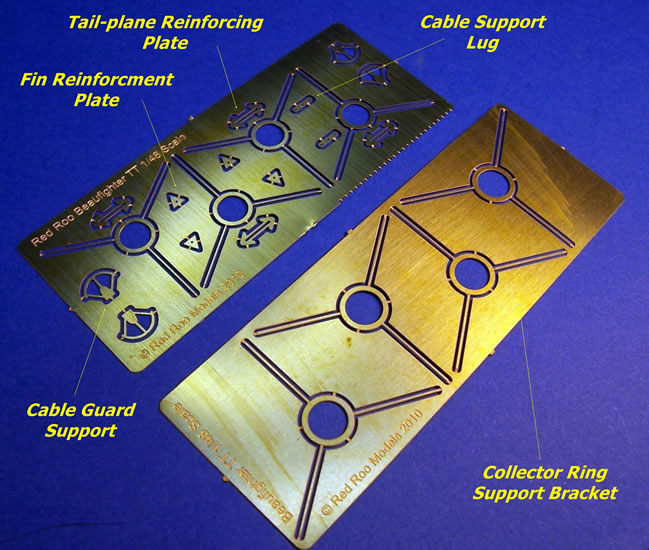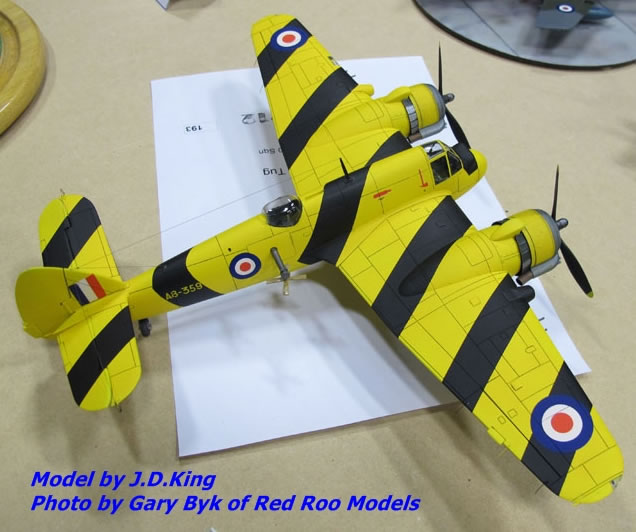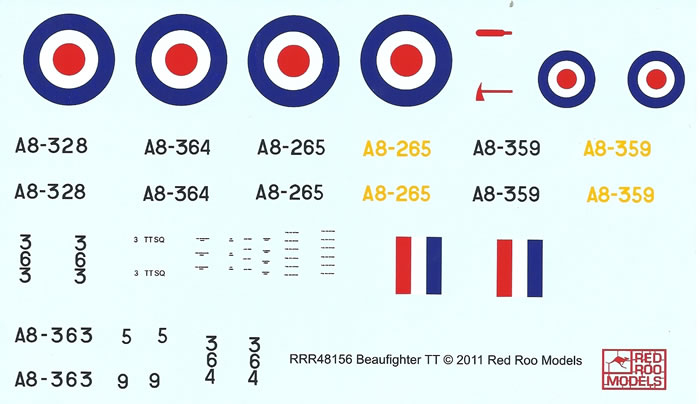RAAF Target Towing Beaufighter Conversion
for the Tamiya Mk.VI kit

Red Roo Models, 1/48 scale
S u m m a r y : |
Catalogue Number: |
Red Roo Models Item No. RRR48156 - RAAF Target Towing Beaufighter Conversion For The Tamiya Mk.VI Kit |
Scale: |
1/48 |
Contents & Media |
Thirty resin parts, one brass tube, various lengths and thicknesses of brass wire, two PE brass frets, two brass mesh discs, two plasticard discs, metallic thread, a small sheet of plasticard, a strip of plastic mesh, and decals for five subjects. |
Price: |
AUD$27.00 plus postage available online from Red Roo Models |
Review Type: |
First Look. |
Advantages: |
Well-researched, extremely thorough instructions, every item and miscellaneous material needed is supplied, and all the components are very good quality. |
Disadvantages: |
None. |
Conclusions: |
Red Roo is unrivalled in my view for their thorough instructions and for supplying all of the odd components needed to complete their conversions. Certainly, this is the case with the one reviewed here.
The resin parts, PE frets and decals are all produced to a high standard. The base kit is also a quality product by Tamiya, despite having been around for a few years now. This combination of quality brands should lead to a problem-free build in my view.
This nicely executed conversion seems to be great value too. I recommend it highly. |
Reviewed by
Mark Davies

HyperScale is proudly sponsored by
Squadron.com
Fighter speeds had increased dramatically during WW2; so by the war’s end the RAAF had need of a more powerful and faster target tug than the obsolete Battle and Vengeance aircraft it had been using in this role. The Beaufighter Mk.21 was already in RAAF service and was well suited to meet this need. The first target tug conversion occurred in November 1945, and fourteen more conversions followed on from this. Beaufighters continued to serve in the target tug role with the RAAF until March 1956.
The Contents
The conversion comes in a sturdy flip-top box with a profile of a target towing Beaufighter on the lid. Inside are three zip-lock bags containing the parts listed in the above table. The quality of resin parts is very good. The PE frets and decals also appear to be very good quality items. Also included are no less than 26 A-4 pages of instructions.
Red Roo gives a background history of target towing Beaufighters with the RAAF, and list the references used to research the conversion. The instructions describe each step of the conversion process in detail. They also include numerous diagrams, black and white and colour photos of real aircraft, a paint and markings guide, and a separate page of templates. Rounding the package out is a sheet of decals.
It is obvious that a considerable amount of research has gone into this conversion. A thorough familiarity with the instructions is vital, as Red Roo have left nothing to chance in the conversion process. The instructions also advise of the tools required and the need for precise measuring. There are plenty of diagrams and instructions dealing with measurements for making holes and cuts, or placing parts. I am sure that a trouble-free build should result if the instructions are followed precisely. Towards their end, the instructions acknowledge those who mastered the conversion and assisted with its research.
The Conversion
Before addressing the conversions itself, I should mention that the instructions cover in depth various minor details that will all serve to enhance the finished model. These include wing tip lights, ID light locations, IFF antenna, flare-chutes and Very pistol-ports, length of gun barrel protrusion, cannon trough removal, and fabric blanking patches. This is indicative of just how thorough Red Roo is, but I do not wish to complicate my description of the main conversion parts by dwelling on these. There are also a number of parts unrelated to the target towing conversion. These include replacement weighted wheels, crew seats, and replacement cowl flaps, exhaust pipe ends all made of resin, plus PE collector ring supports.

RAAF Beaufighter target tugs had rocket stubs fitted, so these need to be added to the Tamiya kit. Red Roo provides these as sixteen separate parts with wire inserts cast in place. The wire needs trimming to a suitable length before inserting the stubs into their locating holes drilled in the wing using a template provided.
A feature of most target tugs was the use of guard wires around the empennage to prevent the target’s tow cable from fouling the elevators and rudder. This distinctive feature will add interest to a target tug model, but is one that needs some care to install. Red Roo provides curved PE cable guards that need to be placed in slots cut in the horizontal stabilisers. There is also a triangular reinforcing plate to fit either side of the fin where the guard wires attach by passing through it. A small PE plate fits underneath the fuselage across the centreline; it is here that the guard wires attach via turnbuckles to the fuselage. The conversion provides metallic thread to make the guard wires, although some may prefer to use other materials for this job. Red Roo thoughtfully includes spare copies of the PE parts used for this part of the conversion.
A major feature of the target tug is of course the winch. This requires that a reinforcing plate be cut from the plasticard included with the set and fixed to the fuselage. Of course, the instructions cover all of the dimensions and position of this part. The resin winch with its impeller attached simply fits onto the reinforcing plate.
Another significant feature of the target tug conversion is the target drogue chute; albeit that this is largely internal. This is the reason for the short length of brass tube that comes with the set. The tube needs to have its exterior open end chamfered for better scale appearance. The tube inserts into a hole cut in the fuselage underside at a slight 83°angle; protruding just below the line of the fuselage. Behind this sits the more prominent pulley fairing made of resin, sitting within which is a resin pulley mast that locates onto a piece of wire. The pulley mast mounts on an underside hatch in the Tamiya kit. The hatch’s hinge and outline need modification, and reinforcement with a plastic strip on the inside.

The target tug used a modified observer’s canopy with a flat rear panel in place of the fully blown item. This was to give the winch operator a clear view of the target and towline. The instructions provide a couple of options as to how to modify the Tamiya kit part to replicate this flat panel. A small reinforcing strip that runs lengthwise just behind the winch operator’s canopy also needs to be made from plasticard.
There a number of general modifications left to do in order to finish the conversion. Most of the kit’s cockpit bulkhead needs to be cut away; as presumably the target tug did away with protective armour for the pilot. There are PE collector ring supports to fit to add further authenticity to the model. Eight of these are provided on two frets, but one set is too small, so the instructions direct that these be ignored in favour of the larger set. Even so, there is still a spare pair of the larger type. The Mk.21’s resin oil coolers replace the Mk.VI kit items. These include some fine mesh discs that affix to plastic discs behind the inlets. The instructions require a hole to be drilled vertically through the oil cooler inlets to enable the insertion of a short length of wire. This wire represents a rod that is quite noticeable on the original inlets. Overall, the oil coolers should look most impressive when finished. The Instructions even point out to align the small hole in the wheel hubs at the 11-oclock position, as this is the entry point for the brake line.
Colours and Markings
The conversion offers markings for five aircraft and gives a service history for each one. For each subject there is a photo image of the aircraft and six-view paint and markings guide. The colour-printed guides have legends that give paint names and either BSC381C or FS.595B codes as applicable. The instructions carry a cautionary note regarding masking of the stripes; they point out that the stripes are not always of a uniform width, and that the paint guides are based on observing photographs as to where the lines start and finish on the airframes concerned. A single page of three-view plans serves to guide stencil placement.

The five target towing Beaufighters covered by the conversion are A8-265, A8-359, A8-363, A8-364, A8-328. The first two have diagonal black lines over trainer yellow on all surfaces, but with solid black undersides to their horizontal stabilisers. The last three have similar black stripes over yellow on their undersides, but with aluminium lacquer on their upper-surfaces. They also have broad yellow stripes just outboard of the engine nacelles and around the fuselage. All are quite eye-catching schemes as would be expected of target tugs.
The decal sheet has national insignia and stencils for one machine, and a choice of the five serial numbers mentioned earlier. The decal registration is good, as is colour density as far as I can tell without testing them.
Towed Targets
Almost at the back of the instructions is a page devoted to producing a 1/48-scale banner target for display it attached to the towline, should you wish to do so. Although not mentioned in the parts list, this is where the plastic mesh supplied with the conversion comes in. The instructions give guidance and have scale plans to help with making a banner target. They also draw attention to Red Roo’s 1/48-scale RFD Winged Target resin kit; this being an alternative to the banner target.
I have reviewed several Red Roo conversions now, and I have found them to have the most thorough instructions of any conversions that I have seen. This said, they do take a few reads to become fully conversant with them, but the time spent should pay dividends once the conversion is started. They also stand out from the crowd by including all the items needed for scratch building; these being items that many other brands would expect the modeller to furnish.
CMR Moulding and Casting make the resin parts I believe; and these, as well as the PE frets and decals, are all produced to a high standard. The base kit is also a quality product by Tamiya, despite having been around for a few years now. This combination of quality brands should lead to a problem-free build in my view.
This nicely executed conversion seems to be great value too. I recommend it highly.
Thanks to Red Roo Models for the review sample.
Review Text Copyright © 2012 by Mark Davies
Page Created 21 August, 2012
Last updated
22 August, 2012
Back to HyperScale Main Page

|
